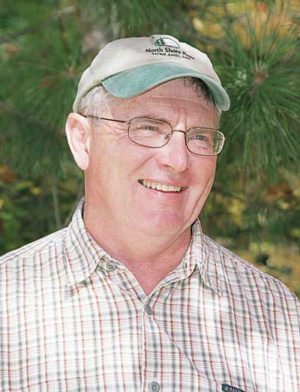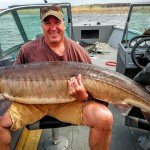Isabella is about the last place in Minnesota where you would expect to see a wild turkey. It is prime habitat for creatures of the North, such as moose and Canada lynx. Yet last fall, while driving up Minnesota Highway 1 early in the morning, we saw a tom turkey beside the road. Later, I mentioned the sighting to a friend who lives in Silver Bay. He wasn’t surprised. He’d been hearing of turkey sightings between Two Harbors and Silver Bay.
This spring, another friend mentioned he saw a hen turkey along Highway 61 at Castle Danger. While wild turkeys are now common immediately south of Duluth, I was curious if the birds were now working their way up the North Shore. So I called Bailey Peterson, DNR assistant wildlife manager in Two Harbors, who said she is getting lots of reports of turkey sightings along Lake County roads. Turkeys now exist along the Shore, but the bigger question is: Where are they coming from?
“We think these birds may be free-ranging from people’s yards,” Peterson said. “It’s difficult to distinguish game farm birds from eastern wild turkeys.”
Peterson said the bird I saw in Isabella was likely from a nearby home. She’s had other reports from there as well. She’s also received reports from the Brimson area and what she believes are the same birds have now been seen as far east as Lake County Highway 2. Turkeys are frequently seen along the Gun Club Road north of Two Harbors. She said those birds are likely coming from a farm there. Two turkeys were also seen in the Beaver Bay area this spring. Peterson hasn’t heard of anyone seeing turkey broods, although a conservation officer living in Knife River saw nine birds in his yard last year.
This spring was the first year the entire state was open to turkey hunting. While the season had just closed when I talked to Peterson and she hadn’t received information from registration stations, to her knowledge no one is hunting North Shore turkeys. Amy Degeorge at Chalstrom’s Bait in Duluth said she hasn’t heard of anyone hunting turkeys north of Duluth, but the birds are there. They are seen within a mile of the shop’s location on the northern outskirts of town, as well as 20 miles farther north at Island Lake.
Randy Bowe, a Duluth taxidermist who manages his property northeast of Two Harbors for deer, had a hen turkey hanging around five years ago and another one this year. He has also seen the birds along Lake County Highway 2, including a hen with eight or nine poults near the Big Noise corner two years ago. Bowe thinks the birds were not of wild origin.
Martha Minchak, DNR wildlife manager in Duluth, believes the birds folks are seeing are not true eastern wild turkeys. She says the pictures she’s seen of birds sighted north of Duluth were Merriams and Rio Grande turkeys—game farm birds. She’s seen no evidence of turkey reproduction north of Duluth, although she’s heard of sightings all the way to Ely. Also, she believes the turkeys are spending their winters indoors, because they lack the habitat and food necessary to survive a northern winter.
The nearest DNR wild turkey release occurred in central Pine County about a decade ago, Minchak said. Offspring from those birds have moved north to a suitable habitat and are now found throughout Carlton County as well as around Meadowlands in St. Louis County. To survive in the north, turkeys need oak forests and access in the winter to cattle operations, where they find food. While turkeys can feed to some degree on aspen buds like ruffed grouse, Minchak said it was a starvation diet.
Duluth wildlife photographer Michael Furtman, who is out photographing almost on a daily basis, says he occasionally sees individual turkeys in the Duluth-Superior area. He thinks they are likely explorers from established populations south of town. However, he doesn’t hear turkeys gobbling in the spring and he hasn’t encountered a brood. But he doesn’t have to travel far to find wild turkeys.
“You don’t have to go very far south of Duluth-Superior to see a lot of them,” he said. “They are common in Douglas County (Wisconsin) and Carlton County.”
Does this mean wild turkeys will continue their northward march, populating Duluth and then moving into the boreal forest of the Arrowhead? Deep snow, plus the aforementioned lack of suitable food and habitat should prevent that from occurring. Bowe pointed out that along the North Shore, where snow depths and cold temperatures are moderated by the influence of Lake Superior and winter deer feeding is prevalent, turkeys might be able to make it. The same may be true in other places where deer feeding is common. While wild turkeys might be able to survive and to some extent thrive in such situations, their existence would be a result of artificial conditions.
If that happens, those turkeys may not be welcomed by their human neighbors. I have talked with folks in Carlton County who are not thrilled that these nonnative birds have taken hold there. Minchak said that when turkeys exist in places where they cannot make it on their own, they often become nuisances: chasing people, pillaging gardens, hanging around bird feeders or eating food intended for livestock. They may even wreak havoc with native species. She says research has found turkeys compete with other birds, including ruffed grouse.
“Turkeys will eat anything,” she said, “including ruffed grouse chicks and eggs.”
While natural conditions will likely be a barrier to turkey expansion in the Arrowhead, the story of another southern critter that made its way into the north is food for thought. Peterson said the DNR’s range map once showed gray fox were only found as far north as U.S. Highway 2. Now they are found throughout the northern Minnesota boreal forest. A trapper friend of mine was catching them around Grand Marais more than a decade ago. I’ve even seen them in my yard in Hovland, less than 20 miles from the Canadian border. Such sightings can lead one to wonder, what’s next?






